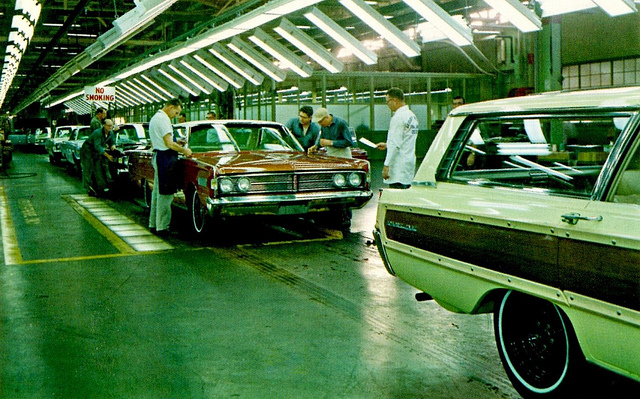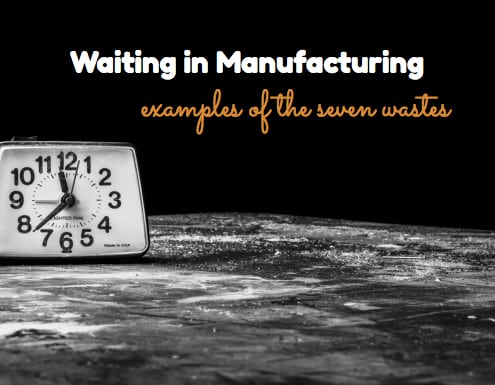Photo Credit: cc Greeblie
Lean Terminology
Seen a word or phrase you don’t recognise? Don’t panic! Our extensive Lean Glossary is here to explain all the abbreviations, acronyms and otherwise unfamiliar lean terminology. From Andon to Zero Defects, we’ve got you covered!
5S
5S is a cycle used in Japanese industries to eliminate the wastes that contribute to defects and also injuries in the workplace. The term 5S refers to the five stages of the cycle which all begin with the letter S in Japanese. They are seiri, seiton, seiso, seiketsu and shitsuke, which when translated into English mean:
- Sort – Sort through the items in an area. Remove all of the clutter and keep only what is required.
- Set – Designate a place for everything that is left.
- Shine – Clean the area. This helps to identify any abnormal conditions that could lead to quality or downtime issues.
- Standardise – Document a process to ensure the first 3 S’s are maintained.
- Sustain – Keep the work area in this state and improve upon it.
Implementation of the 5S’s is a simple and quick way to make improvements to a process. Over a period of time wastes can build up and hide problems to such an extent that they become accepted. By performing 5S on a process it may make identification of root causes much easier.
See 5 Pillars of the Visual Workplace: Sourcebook for 5S Implementation (For Your Organization!) by Hiroyuki Hirano
Andon
Andon is a Japanese term which means signal. It is used to notify team leaders and supervisors that an out of standard condition has occurred. This allows them to react in a timely manner to fix the issue. Andons can take the form of an audible signal like a siren, or a visual signal such as a flashing light.
See The Toyota Way: 14 Management Principles from the World’s Greatest Manufacturer by Jeffrey K. Liker
Flow
Flow is the state where product moves from one operation to the next, in the right quantity, at the right time, without delays or other wastes. In reality this is uncommon as inventory fluctuates between processes, defects occur, output varies and workers are either under utilised or overburdened. The aim of a lean process is to create continuous flow from raw material all the way through to delivery to the final customer.
See Creating Continuous Flow: An Action Guide for Managers, Engineers and Production Associates by Mike Rother & Rick Harris
Inventory
Excess inventory is one of the seven wastes. This is because it ties up money in the process. Inventory includes raw materials, work-in-progress (WIP), and finished goods. This capital outlay has not yet produced any income, therefore, any inventory over and above what is required to run the process is waste.
Mistake Proofing
See Poka Yoke
Nemawashi
Nemawashi refers to the Japanese process of decision making by building consensus. It is common to explore an idea and get feedback by discussing with various individuals to develop the idea. This helps to ensure the idea or plan is robust and that everybody is bought into it. This is turn allows for rapid implementation once the solution is agreed upon.
Poka Yoke
Poka-yoke is a concept created by Shigeo Shingo to reduce the risk of a human error turning into a defect. It is typically a device that is used to either detect or prevent defects from occurring in the first place. The benefits to the business are that less energy, time and resources are wasted.
Poka-yokes are a cost effective alternative to full automation:
“Simple fail-safe methods are the low-cost route to parts-per-million error rates”.
~Hall, 1987
See Poka-Yoke: Improving Product Quality by Preventing Defects by Nikkan Kogyo Shimbun
Pull
The alternative to a Pull system, is a push system. In a push process, each operator makes as much product as possible and ‘pushes’ it to the next downstream operation with no regard for what impact it has on the overall performance of the line. This leads to accumulation of WIP at the bottleneck process and eventually, when it becomes unsafe, the line must stop.
In a pull system however, each operator only produces a component when the downstream operator ‘pulls’ from their station. This prevents the build-up of inventory, as well as reducing the number of defects produced and preventing downtime.
See Creating Level Pull (Lean Tool Kit) By Art Smalley
Quick Changeover
Quick Changeover is also commonly referred to as Single Minutes Exchange of Die (SMED). The idea is that when a machine changes over from producing one part to a different part, it is not adding value. This time is therefore non-value adding and should be reduced as much as possible. The aim is to reduce changeover time to less than ten minutes. This is done by completing as many of the external elements of the changeover while the machine is still running, e.g. fetching the new tools and components. That way the minute the last cycle is finished, everything can be changed quickly and efficiently according to standard work. There is no looking for a wrench, or waiting for the maintenance team member. A world class example of a quick changeover is a Formula One pit stop.
Root Cause Analysis
5 Whys is a tool that is used to find systematic causes of a problem so that an appropriate corrective action can be implemented. It simply involves asking why at least five times until a root cause is established. The root cause, is the problem that if solved, prevents that issue recurring again. It requires taking the answer to the first why and asking why that occurs (LIKER, 2004).
Standardised Work
Standardised work is defined as work in which the sequence of job elements has been efficiently organised, and is repeatedly followed by a team member (DENNIS, 2002). It represents the best way to do things and prevents the need to reinvent the wheel with every new project or manager.
Best practices are documented and a copy is available at every work station for reference by the operator. An important part of standardised work is the opportunity for the operator to make suggestions about how the process might be improved. These are tested and where they prove to be successful get incorporated into the documentation. Standardised work is one of the fundamental elements of the highly acclaimed Toyota Production System, as it maintains predictability, regular timing and regular output of processes (LIKER, 2004).
SMED
See Quick Changeover
Zero Defects
Zero defects is a state in a production facility where no reject products are passed forward to the customer. This is achieved through using source inspections, not using sampling inspections, minimising the time to carry out corrective actions and implementing effective poke yokes.
See Zero Quality Control: Source Inspection and the Poka-Yoke System by Shigeo Shingo
Obviously, we haven’t been able to cover everything in this list. If you believe there is some lean terminology missing from this list, please send us a note and we’ll get it added as soon as we can!



